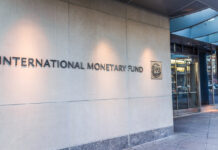The Hamas-Israel War did not come out of the blue. And it is not just paving the way to the destruction of Hamas or a hellish ground assault. It seeks to devastate Gaza and could result in expulsions in the West Bank over time. The War will inflame violence within and around Israel. It could escalate across the region. It reflects the failure of 50 years of U.S. geopolitics in the region and will further penalize global economic prospects.
Neither apartheid nor violence can secure an enduring peace in the early 21st century. What is needed is multilateral cooperation and multipolar diplomacy in the region – before it’s too late.
On October 7, roughly 50 years after the Yom Kippur War, several Palestinian militant groups, led by Hamas, launched a coordinated offensive against nearby Israeli cities, Gaza border crossings, and adjacent military installations, which led to Israel’s rapid, lethal counter-offensive. After the brutal Hamas offensive, odd even in view of the violent history of the region, the Israeli preparation for a massive ground assault to destroy Hamas poses an existential threat to 2.3 million Gazans in the region.
That’s the standard narrative. But it’s not what has been taking place behind the façade. That’s far worse.
The Hamas-Israel War is not just the first major direct conflict within Israeli territory since the country’s founding. It is also the latest manifestation of Israel’s “strategy of tension” dating from the aftermath of the 1973 Yom Kippur War and the rise of U.S. economic and military ties. This tension has been seen in several countries, including during Italy’s “years of lead”; a period of extraordinary social turmoil, political violence and economic volatility that lasted two decades. Starting in the late 1980s, it was marked by a wave of false flag terror, first attributed to the far-left but later linked with far-right, as well as Italian and U.S. intelligence agencies.1 The strategic objective is to use a general sense of insecurity against targeted groups and to buttress an increasingly repressive government. As geopolitics replaces development, economic welfare suffers, but the perceived common enemy is expected to “unite the nation.”2 Historically, the strategy of tension has paved way to neoliberal economics; for example, the 1973 Pinochet regime relying on U.S.-trained Chicago economists in Chile.3
In contrast to the standard narrative, the Hamas war is manna from heaven to Benyamin Netanyahu’s far-right government, which has escalated the suppression of Palestinians ever since international attention has focused on the proxy war in Ukraine. It certainly did not come out of the blue. Netanyahu himself has contributed to the creation of Hamas since the ‘90s. In effect, the strategic tension has lasted more than five decades in Israel. But since late 2022, it has been accelerated by the most far-right cabinet in Israel’s history.
Legitimisation of far-right extremism
In July, the ex-chief of Mossad Tamir Pardo (2011-16) charged prime minister Binyamin Netanyahu for bringing parties “worse than the Ku Klux Klan” into his government.4 He had a point (Figure 1).
Figure 1. Some Controversial members of Netanyahu far-right cabinet

(From left to right) Itamar Ben-Gvir, Bezazel Smotrich, Israel Katz
Since the tumultuous 70s, far-right politics, violent Messianic settlers and ultra-nationalists like Rabbi Meir Kahane’s Kach have given rise to far-right movements, massacres of Palestinians and political parties like Otzma Yehudit (Jewish Power), Kach’s ideological successor. Its leader, Itamar Ben-Gvir, first gained national notoriety in 1995 by brandishing a Cadillac hood ornament that had been stolen from Prime Minister Yitzhak Rabin’s car. “We got to his car, and we’ll get to him too,” Ben-Gvir said proudly.5 Weeks later, Rabin, the architect of the peace process, was assassinated.
As Netanyahu’s minister of national security, Ben-Gvir has espoused Kahanism. As a settler, he lives in an illegal settlement. He has openly called for expulsions of Arab citizens. His provocative visit to the Temple Mount, the locale of al-Aqsa Mosque, contributed to the onset of the ongoing turmoil.6
Another fatal mistake of the Israeli government has been the decision of Netanyahu’s energy minister Israel Katz that no “electrical switch will be turned on, no water hydrant will be opened and no fuel truck will enter” until the “abductees” would be free.7 Reminiscent of Nazi practices, such collective punishments are morally flawed and counter-productive in practice. When revenge massacres are imposed on innocent civilians, they will breed new resentment, new bitterness, and generations of resistance.
Through his 20 years of participation in Israeli cabinets, Katz has fought for more resources for settlements. Opposing any two-state solution, he pushes for the annexation of the West Bank and wants to make Gaza Egypt’s headache.
Netanyahu’s minister of defence is Bezazel Smotrich, a vehement opponent of a Palestinian state and a self-proclaimed fascist, racist and homophobe, who also lives in an illegally built West Bank settlement. In 2021, he declared that Israel’s first prime minister, David Ben-Gurion, should have “finished the job” and kicked all Palestinians out of Israel when it was founded. He believes that members of Israel’s Arab minority communities are citizens, but only “for now”.8
When Smotrich was entrusted with much of the administration of the occupied West Bank, the fox took over the hen house. It was a signal to Palestinian Arabs: Leave!
These are the hollow men in Netanyahu’s government. Neither they nor their peers will ever support policies recognising the sovereign and human rights of the Palestinians.
From democracy to autocracy
Since January, the Netanyahu government has pushed for highly controversial judicial reforms, a series of changes to the judicial system and the balance of powers. The effort has been led by Netanyahu’s deputy PM and minister of justice, Yariv Levin, and the chair of the Knesset’s constitution committee, Simcha Rothman. Levin fought Israeli withdrawal from Gaza, opposes a two-state solution and supports settlers.9 A critic of Netanyahu’s corruption trial, Rothman represents the militant, anti-Arab Religious Zionist Party that promotes far-right Kahanism and Jewish supremacy and supports the annexation of occupied territories to Israel.10
The amendment was passed by Israel’s parliament, the Knesset, in late July. It seeks to limit the Supreme Court’s power to exercise judicial review, granting the government control over judicial appointments. It caused a political and constitutional turmoil that came to a head on 12 September, when the Supreme Court heard oral arguments in the case. The judicial reform effort reflects descent toward autocracy and was opposed by most Israelis in massive protests.
In the past, Israel’s judiciary has regularly upheld policies, practices and laws that helped enforce “Israel’s system of apartheid against Palestinians”, including upholding administrative detentions, green-lighting the destruction of villages, and imposing restrictions on family reunification. But on some occasions, the Supreme Court has intervened in protecting Palestinian rights. If the institution loses power to the government, even this “slim and inconsistent” protection would disappear. In view of critics, the proposed overhaul would have chilling implications for Palestinian rights.11
Hoping to undermine the Israeli democracy, Netanyahu’s bedfellows seek to transform Israel within and annex the occupied territories. Given that the coalition government held a 64-seat majority in the 120-seat Knesset prior to the Hamas war, opposition parties can do little within the legislature to stop judicial reform.12
Marginalisation of the peace movement
While the roots of the Israeli-Palestinian nightmare were planted 50 years ago, the ongoing Hamas-Israel war has been on the cards for years.13 After the 1967 Six-Day War, Israel occupied the West Bank, including East Jerusalem, Gaza and the Golan
Heights. Since then, Israel has allowed and even encouraged its citizens to live in these settlements, often motivated by religious, ultra-ethnic and ultra-nationalist sentiments attached to Jewish history and the land of Israel.
On the eve of the Yom Kippur War in 1973, I toured West Bank and Gaza Strip, as well as the Golan Heights, and interviewed both the colonisers and the colonised. What I found most ominous was the gap of perceptions between the two. The Israelis saw a bright future and thought they were paving the way to lasting peace. The Palestinians saw no future and dreamed of a land of their own.
After the Yom Kippur War, Israel’s Labor coalition began to intensify the expansion of the boundaries of Jerusalem eastward. This encouraged a group of Messianic settlers to create a foothold in the West Bank, including Ma’ale Adumim by the group Gush Emunim.
These religious far-right Jews were met with protests by the peace activists.14
Among the peace movement’s leaders was the author Yael Dayan, the daughter of general Moshe Dayan and future Labor politician and feminist. Like in 1973, Dayan said recently that “there is not and there cannot be a real and lasting peace that can be reconciled with the massive colonisation of the Occupied Palestinian Territories.”15 After discussions with her, I joined the movement and the protests. I saw the settlements as a time bomb that could subvert Israeli democracy, endanger Israel’s Jewish and Arab citizens and Palestinians, morph into apartheid, and cause a cycle of “forever wars” with its Arab neighbours.
One of the founders of the “Peace Now” movement was the late novelist Amos Oz, a dear friend whose book on the settler-induced divisions In the Land of Israel (1983) I would later translate. He was among the first Israelis to advocate a two-state solution to the Israeli-Palestinian conflict. Oz warned of the dangers of the occupation already back in1967 and called the radicalized settlers neo-Nazis (Figure 2). At the same time, he also said he loved Israel, “even when I can’t stand it”. In one way or another, all of us were called “traitors”. But like Amos, we’d respond: “At least we’re in good company.”
Figure 2. “Corrupting Occupation”
 “Even unavoidable occupation is a corrupting occupation; an enlightened and humane and liberal occupation is occupation.” Amos Oz, 1967
“Even unavoidable occupation is a corrupting occupation; an enlightened and humane and liberal occupation is occupation.” Amos Oz, 1967
In retrospect, the early peace efforts were vital, but no match to the settlement policies that have been legitimised in terms of national security interests and fuelled by massive arms trade and the US Big Defense. Like the peace movement, international community considers the settlements a violation of international law.16 Yet, hawkish advocates of national security favoured their expansion. For all practical purposes, they have won. In the early 1970s, there were barely 2,000 settlers in the West Bank. Today, that figure exceeds 500,000. Their problem is that they will never win the peace.
Far-right terror and assassinations
Among the peace activists, the concern was that if the Messianic far-right Jewish settlers, many of whom came from the US, would be permitted to create a substantial de facto presence, it would be legitimised over time by de jure measures.
In the 1980s, Gush Emunim radicalised further, forming the Jewish Underground, a radical terrorist organisation. Two issues contributed to its creation: the Camp David Accords that led to the Egypt-Israel peace treaty in 1979, which the movement vehemently opposed, and the settlement project itself, which brought the far-right Messianic Jews in close proximity with Palestinian communities.17
Through the first half of the 1980s, the Underground conducted several vicious terror attacks, including car bombs against Palestinian mayors, and plotted to blow up the Dome of the Rock at the centre of the al-Aqsa mosque. The effort was to exploit terror to drive Palestinians out of the occupied territories.18
I had no doubts of these extremist trajectories after a mid-70s meeting in Jerusalem with the US-born Rabbi Meir Kahane, the far-right ultra-nationalist politician and later a member of the Knesset until his conviction of terrorism. Having co-founded the far-right Jewish Defense League in the US, Kahane established the ultra-radical Kach in Israel. Both used terror to advance their aims. In the late 1950s, Kahane’s fanatic anticommunism had made him an “informant” with the FBI.19 By the 70s, he promoted ethnic cleansing of Palestinians. As he said at the time, “Every day the Arabs of Israel move closer to becoming a majority. Israel should not be committed to national suicide. Why would we allow demography, geography, and democracy to push Israel closer to the abyss?”
I had never met anyone as full of hate and fully expected Kahane to die in violence (Figure 3).
Figure 3. “Kahane was right”
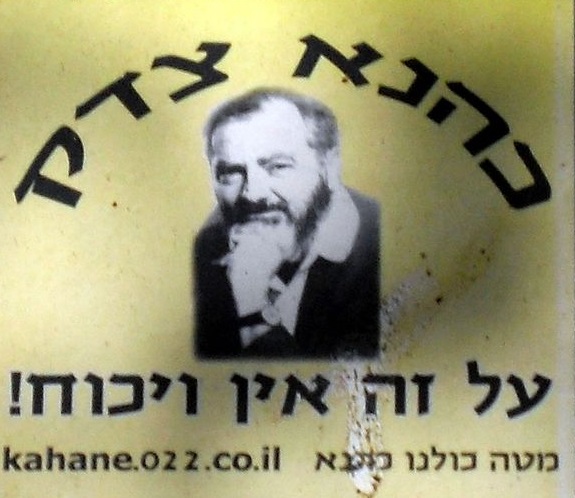
“Kahane was right, about this there can be no debate!”
A not-so-subtle reference to the need for ethnic cleaning in the Occupied Territories (Sticker in Jerusalem, 2010)
Fast-forward to November 1990. As I was walking to Grand Central, I heard shots and saw a man running. Kahane had been assassinated in midtown Manhattan. But his spirit lived on. Just four years later, Yigal Amir assassinated Israeli prime minister Yitzhak Rabin. Amir was associated with religious extremists influenced by Kahanism. Like the Hamas offensive, the assassination was initially attributed to an “intelligence failure”. In reality, the murder was due to the failure of Israel Security Agency (ISA, or Shin Bet). The ISA could have stopped the killer in advance.20
Was the assassination “allowed” to happen by the far-right that had most to gain from it?. In a sense, Rabin’s assassination was the Israeli mirror image of the prior Sadat’s assassination, which has been attributed to the Egyptian Islamic Jihad (Figure 4). Their members later figured among the fedayeen in Afghanistan that were armed, trained and financed by the CIA’s Operation Cyclone.21
The assassinations’ message to peacemakers was loud and clear: Don’t even try!
Figure 4. Two peace accords, two assassinations
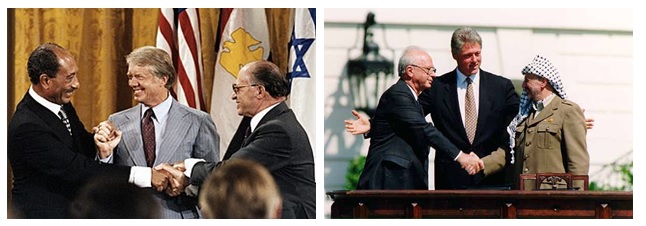
(Left) President Anwar Sadat, President Jimmy Carter and Prime Minister Menachem Begin at Camp David on 17 September 1978
(Right) Prime Minister Yitzhak Rabin, US President Bill Clinton, and PLO’s leader Yasser Arafat at the Oslo Accords signing ceremony on 13 September 1993.
These polarising trends occurred in parallel with the plunge of Israeli Labor, US economic and military aid and growing influence of neoliberal economics.
Plunge of the Labor alignment, US aid and neoliberalism
During the early days of independence, Israel’s politics was dominated by Labor alignments from David Ben-Gurion to Golda Meir. In 1949, the Labor alignment (46) and the left (25) had over 70 seats in the 120-member Knesset. Despite near monopoly, the Labor (51)-left (11) still held over 60 seats in 1973. In other words, Labor actually increased its voice, while the left lost half of its seats. Today, the Labor coalition has lost more than 90 per cent of its representation some 75 years ago (Figure 5).
Figure 5. Rise of US aid, decline of Israeli Labor
Fall of Israeli Labor coalitions since 1974
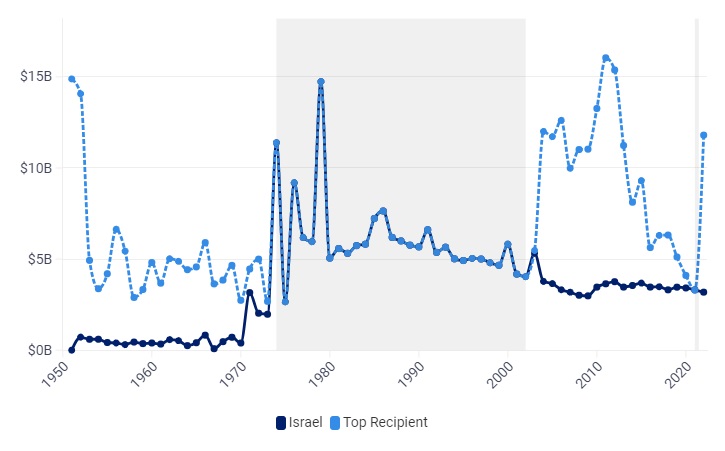
US aid to Israel since 1950
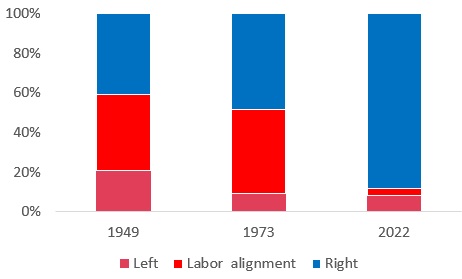
The debate on the decline of Israeli Labor is long-lasting.22 Usually, the losses are attributed to the failure of the Oslo Accords to make Israelis feel more secure, inability of the alignment to attract Labor voters, failure to stay attuned to demographic shifts, and the overall decline of social democratic parties in Western Europe.
Yet, most analysts fail to associate the parallel trends of the plunge of Israeli labor and the rise of U.S. aid. The erosion hasn’t been gradual and incremental, but disruptive. Even the air triumphs of the Six-Day War were still premised on the French-made Mirage and Super Mystere jets. The US economic and military aid soared only after the 1973 War. Until 2002, Israel was the top recipient of U.S. aid, and it has stayed among the top three with Iraq, Afghanistan, and Ukraine. U.S. has given Israel over $260 billion in military and economic aid, and $10 billion more for missile defense systems.
For decades a key player in cementing this tie (and undermining Israeli Labor) has been Netanyahu, who has led six Israeli cabinets in the past 25 years. Unsurprisingly, he remains haunted by corruption charges. Through a decade, he has faced a litany of bribery, fraud and breach of trust charges. He needs to stay in power to avoid prosecution.
Despite US aid, the Israeli economy is today more polarised than ever before. Even before the Hamas war, economic growth was slowing. Risks to the outlook were tilted to the downside and risks to inflation to the upside. Continued uncertainty about the judicial reform presented another notable downside risk. Both have been exacerbated by the Hamas war, which Netanyahu has pledged will continue for a long time.23
Worse, due to neoliberal growth policies that Netanyahu has long advocated, Israel has relatively high inequality compared to other OECD countries, despite its early socialism. Long-term trends are alarming. In May, 280 senior economists warned that the government’s budget allocations to the ultra-religious Haredi groups in exchange for their coalition support “will transform Israel in the long run from an advanced and prosperous country to a backward country”.24 The economic backlash associated with the proposed judicial overhaul has already been manifested in a massive capital flight and a sharp decline in foreign investment, resulting in currency depreciation, a sluggish stock market, a slowdown in tax revenues, and rising public debt.25
If the Hamas war threatens to exacerbate Israel’s social and economic tensions, it risks turning Gaza into a desert and the West Bank into a Jewish suburbia.
Gaza’s nightmare and the rise of Hamas
With a population of over 2 million on some 365 square kilometres, the Gaza Strip is one of the world’s most densely populated areas and “largest open-air prison”. After the 1948 Arab-Israeli War, it became an Egyptian-administrated territory. Following the 1967 Six-Day War, it came under Israeli occupation. The precursor of Hamas, Al Mujamma al Islami (“The Islamic Centre”), was established in the Israeli-occupied Gaza in the 1970s under the auspices of the Palestinian Muslim Brotherhood.26
One of their adherents was the wheelchair-bound Sheik Ahmed Yassin, the future leader of Hamas. Yassin concentrated the Mujamma’s activities on religious and social services. Ironically, Israeli authorities actively supported its rise, when their main antagonist was the late Yasser Arafat’s Palestinian Liberation Organisation (PLO).
While PLO operatives in the occupied territories faced brutal repression, the Islamists affiliated with Egypt’s banned Muslim Brotherhood were allowed to operate in Gaza. Israelis hoped to use the Islamists against PLO.27
Yassin was jailed in 1984 on a 12-year sentence, but released only a year later. At the time, when Netanyahu still served as the Israeli ambassador to the UN, I interviewed him about his Fighting Terrorism (1986), which offered lessons on “how democracies can defeat domestic and international terrorists”. Fast, smart and slick, he represented a new generation of Israeli politicians trained by American PR experts and his former employer, global consultancy BCG. To them the ambitious right-wing Likud politician was manna from heaven.
Launched in 1988 amid the first intifada (uprising), Hamas has always refused to accept the existence of the Israeli state. When the peace process began between Rabin and Arafat, Yassin was again in prison. Hamas launched a campaign of attacks against civilians, which contributed to the rise of Netanyahu and the Israeli far right in 1996 (Figure 6).
Figure 6. Strange bedfellows
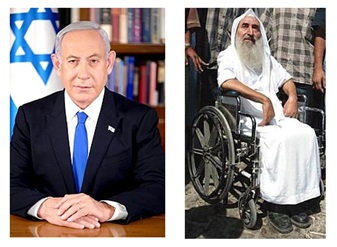
(Left) Prime minister Benjamin “Bibi” Netanyahu’s official portrait, 2023
(Right) Sheikh Ahmed Yassin in Gaza, in early 2004
Intriguingly, Netanyahu, as prime minister, ordered Yassin to be released from prison (“on humanitarian grounds”), despite his life sentence. He seems to have relied on the Islamists to sabotage the Oslo Peace Accords. After having expelled Yassin to Jordan, Netanyahu allowed him to return to Gaza as a hero in late 1997. Until his killing in 2004, Yassin initiated a wave of suicide attacks against Israelis. As Netanyahu later told his Likud Party’s Knesset members in March 2019, “anyone who wants to thwart the establishment of a Palestinian state has to support bolstering Hamas and transferring money to Hamas. This is part of our strategy – to isolate the Palestinians in Gaza from the Palestinians in the West Bank.”28
In the 1990s, as part of the Oslo Accords, most of Gaza had been handed over to the Palestinian National Authority, alongside the Israeli settlements, which were evacuated in 2005, despite intense opposition by Israeli far right. In 2007, after a legitimate Hamas election victory that rankled both the West and Fatah, the Islamist group took over and began administering Gaza. That led both Israel and Egypt to impose a land, sea and air blockade, which devastated the poor, ailing economy.
Before the global pandemic, Gazan Palestinians organised widespread protests demanding that Israel end the blockade and address the Palestinian-Israeli conflict. Already two years ago, Gaza’s economy was on the verge of collapse.29 Yet, those interests that had most to gain from such a humanitarian crisis allowed it to proceed to its inflection point.
The final solution of Netanyahu government’s far right seems to be the devastation of Gaza and the twisted hope that this would cause a mass emigration of Gazans away from the Israeli border. Hence, the preference for the Dahiya Doctrine, outlined by former IDF Chief Gadi Eizenkot in the 2006 Lebanese War and in the 2008-9 Gaza War. It is premised on the destruction of the civilian infrastructure of “hostile regimes”.
“What happened in the Dahiya quarter of Beirut in 2006 will happen in every village from which Israel is fired on… We will apply disproportionate force on it and cause great damage and destruction there. From our standpoint, these are not civilian villages, they are military bases… This is not a recommendation. This is a plan. And it has been approved.”30
Scholars of international law have called it “state terrorism”.31 In view of the UN, it is a “carefully planned” assault intended “to punish, humiliate and terrorise a civilian population”.32 In Gaza, it looks increasingly like a war crime of historical magnitude.
After the Hamas offensive, Eisenkot was appointed as a minister without portfolio in Netanyahu’s war cabinet.
West Bank settlements, apartheid regime
The Jewish settlements have fostered a de facto one-state reality in Israel, wherein Israelis have rights and Palestinians don´t. Meanwhile, talks for a two-state solution have been stalling since 2014.33 Rhetoric aside, Netanyahu’s government has “engaged in actions that annex the West Bank and threaten the prospects for a just and lasting resolution to the Israeli-Palestinian conflict”.34
In the past, periods of heightened security tension and military operations have ensured an opportunity for settlers to establish facts on the ground. After the brutal attack by Hamas, the alarming trend of increased settler violence has rapidly escalated. Nothing has halted the settlers’ steady expansion since the late 1960s and the Israelis’ expansion in East Jerusalem (Figure 7).
Figure 7. Expansion of Jewish settlers in the West Bank, 1967-2021

In South Africa, the system of apartheid, based on white supremacy and racial segregation, was in place from 1948 until 1994. In April 2021, the Human Rights Watch warned that Israel had crossed the apartheid threshold.35 In early September this year, the ex-chief of Mossad Tamir Pardo said that Israel’s mechanisms for controlling the Palestinians matched the old South Africa. “There is an apartheid state here,” since “two people are judged under two legal systems”.36
Even amid the peace talks in Oslo in the early 90s, Palestinian per capita income was just 15 per cent relative to the Israeli level. But hopes for peace died with the Jewish far-right assassination of Prime Minister Yitzhak Rabin. Despite all the hoopla by the Trump and Biden administrations that the Middle East is at the cusp of peace and prosperity, Palestinian per capita income has fallen and is now only 12.9 per cent relative to the Israeli level, lower than decades ago.37
As bad as these aggregate figures are, they reflect Palestinian averages, not Gaza’s hell. Years of isolation and recurrent conflicts have left the local economy far behind the West Bank’s, due to the Israeli-imposed blockade, four wars, and domestic divisions.
Gazan per capita income is now less than a third of that in the West Bank. Half of the labour is unemployed; over half of the population lives below the national poverty line.38
Long before the Hamas offensive, Palestinian stagnation reflected economic ruin that was excessive even relative to apartheid South Africa. During the apartheid (1948-94), the blacks’ per capita income relative to the whites climbed from 8.6 per cent to 13.5 per cent. In relative terms, the Palestinians’ starting point relative to Israelis was almost twice as high after the Oslo Accords. But today it’s behind that of the blacks at the end of the apartheid. The reversal occurred under the watch of the Trump and Biden administrations (Figure 8).
Figure 8. From apartheid South Africa to West Bank/Gaza
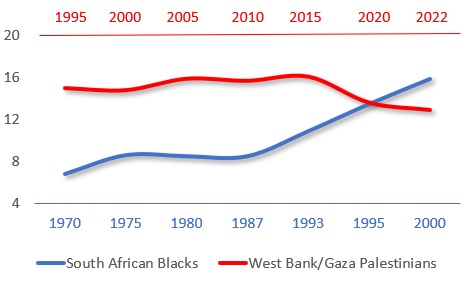
Farsighted Israeli leaders no longer deny the reality of apartheid. Last year, former attorney general Michael Ben-Yair called Israel “an apartheid regime”. Recently, the parliament’s former speaker Avraham Burg and renowned historian Benny Morris were among more than 2,000 Israeli and American public figures who signed a public statement that “Palestinians live under a regime of apartheid.”39
Hall of mirrors
The standard narrative about the Hamas-Israel war is a mere façade. Even the argument that Hamas’s offensive was an “intelligence failure” doesn’t seem valid. Based on two years of video evidence, Hamas militants trained for the brutal attacks in at least six sites across Gaza in plain sight and less than a mile from Israel’s heavily fortified and monitored border.40 For all practical purposes, the offensive was preventable. If the intelligence failure wasn’t a failure at all, what was it?
Similarly, the naïve story about Hamas as Israel’s nemesis doesn’t hold water. The group and its brutal attacks went hand in hand with more than two decades of the rise of Likud and the far-right. Just as the Operation Cyclone had led the U.S. to train, arm and finance a generation of Islamist fedayeen in Afghanistan, including Osama Bin Laden, Israelis thought they could use Hamas; not that Hamas could use them.
Moreover, the war in Gaza serves as a smokescreen to the escalation of settler expansion and violence in the West Bank, which Netanyahu’s far-right ministers hope would result in its annexation and Palestinian expulsions.
Regionally, the war has led Biden’s hawks to refocus attention to Iran. It’s an old project. Since 2003, US Army has conducted an analysis called TIRANNT (Theater Iran Near-Term) for a full-scale war with Iran. Reportedly, this contingency plan (CONPLAN 8022) would be activated in the eventuality of a second 9/11, on the presumption that Iran would be behind it.41 Expectedly, the war has inflamed tensions with Hezbollah in southern Lebanon, which many in the Congress and the White House would like to link with Iran, to legitimise a major regional confrontation.
Tellingly, after the Hamas attack, when Republican senator Lindsay Graham was asked whether he wanted the US and Israel to “bomb Iran even in the absence of direct evidence of their involvement,” he responded, “Yeah.” The answer stunned even the CNN interviewer, so she asked the question twice and got the same response.42 Recently, Rep. Michael McCaul, the Republican chair of the U.S. House Foreign Affairs Committee, said his panel is drafting legislation to authorize the use of military force in Iran, although U.S. intelligence has said there is no evidence to support the claim of Iran’s direct involvement. McCaul’s comments came on the 21st anniversary of the enactment of a measure that authorized the 2003 misguided U.S. invasion of Iraq.
To Netanyahu’s government, an Iran conflict would divert attention from Gaza and the West Bank. It’s a long dream. In 2011 Netanyahu ordered the Mossad and IDF to prepare for an attack on Iran within 15 days, until Pardo and then-Chief of Staff Benny Gantz – now in opposition but a key member in Netanyahu’s not-so-united war cabinet – questioned the Prime Minister’s legal authority to give such an order without cabinet approval. So, Netanyahu backed off.43 But Iran remains on the government’s agenda. And some critics argue that it is part of the Gaza war agenda. A month ago, in parallel with the domestic Supreme Court turmoil, Netanyahu’s Mossad chief David Barnea vowed to target Iran’s “highest echelon”, if Israeli Jews would be hurt in terror.44
Nor has the Biden administration avoided the temptation to use the war and its “solidarity with Israel” as a demonstration effect for other hotspots. When Defence Secretary Lloyd Austin met with Netanyahu and members of the Israeli war cabinet, he conveyed the US’s “ironclad support” for Israel. It is the liturgical term that the White House has used in the context of Japan, Taiwan, Ukraine, the Philippines, and other major US non-NATO allies that have committed to common defence objectives, military bases and arms purchases from US Big Defense, such a Raytheon, Austin’s former employer.45
Giving peace a chance, finally
The ongoing war has severely undermined US credibility as a neutral broker in the region. Officially, Washington seeks to de-escalate tensions. But rhetoric aside, as Israel escalated its counter-offensive, US diplomats were being discouraged from publicly using phrases that would urge calm. In leaked messages, State Department staff wrote that high-level officials did not want press materials to include three specific phrases: “de-escalation/ceasefire”, “end to violence/bloodshed”, and “restoring calm”.46 It preceded the U.S. veto in the UN Security Council to block a “humanitarian pause” and corridors into Gaza.
The Democratic Biden administration has continued Trump’s Middle East policies, which effectively ignore the Palestinian nightmare. Washington’s bipartisan consensus is driven by the priorities of the Pentagon and the Big Defense, which profits from every new major violent conflict by selling security without peace. The Gaza war is a textbook case (Figure 9).
Figure 9. Israel-Gaza War: Latest Casualty Figures, Oct. 19, 15.30 GMT
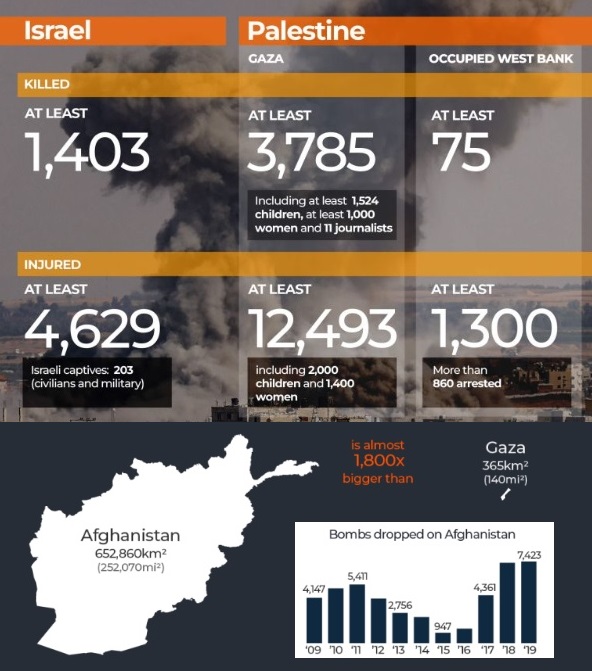
In the first week of its counter-offensive, Israel dropped 6,000 bombs on Gaza. That’s almost the number of bombs the U.S. dropped on Afghanistan in an entire year. But that may be just a prelude to what’s looming ahead. If and when the expected Israeli ground assault – a “disaster foretold,” as the Israeli columnist Gideon Levy puts it – will begin, all these casualty figures will pale in comparison.
When 1 million people are internally displaced, 90,000 residential units are damaged, electricity and water are effectively denied (and all this before the actual assault), the consequent damage can no longer be considered collateral but intended. And if health systems collapse, misery and vice will follow in the form of famine, epidemics paving the way to new massacres and new wars.
Today, the worst economic risks are unwarranted geopolitical tensions. The outbreak of the Israeli-Hamas War is threatening to inject new volatility back into energy markets, harking back to last year’s commodity chaos after the proxy war in Ukraine. As Biden made his primetime case for “wartime aid to Israel and Ukraine,” he expanded U.S. involvement into two major fronts; multiplied the need for tens of billions of dollars in military aid in addition to the past hundreds of billions of dollars; and accelerated the probability of a looming U.S. debt crisis that could have global repercussions.
After $8 trillion in the misguided post-9/11 wars in Afghanistan and Iraq, U.S. war theaters have not disappeared. It’s only the arenas that are shifting. The Biden administration is preparing another unwarranted Global Cold War in a perceived Manichean world of “noble democracies” and “evil autocracies.”
In the past half a century, no US-brokered initiative has achieved enduring peace in the Middle East. Washington has a geopolitical interest in the region as an energy reserve and US defence contractors’ lucrative client. By contrast, China’s approach is premised on stability and cooperation that are necessary for economic development. Stressing the importance of peace and development, Beijing has called for an “immediate ceasefire” and repeated its support for a two-state solution with an independent state of Palestine as a way out of the conflict.
Both the US and China have a role in the Middle East. But without peace, there can be no stability. And without stability, there can be no development. Half a century of wars, colonisation and apartheid will never bring peace to the region; but they will surely ensure more despair, more wars and more dead and injured civilians. What is needed in the region is multilateral cooperation and multipolar diplomacy.
It is time to give peace and development a chance – before it’s too late.
About the Author
 Dr. Dan Steinbock is the founder of Difference Group and has served at the India, China and America Institute (US), Shanghai Institute for International Studies (China) and the EU Center (Singapore). For more, see https://www.differencegroup.net/.
Dr. Dan Steinbock is the founder of Difference Group and has served at the India, China and America Institute (US), Shanghai Institute for International Studies (China) and the EU Center (Singapore). For more, see https://www.differencegroup.net/.
References:
- See e.g., Bull, Anna Cento. 2012. Italian Neofascism: The Strategy of Tension and the Politics of Nonreconciliation. Berghahn Books; Dossi, Rosella. 2001. “Italy’s Invisible Government.” University of Melbourne. Contemporary Europe Research Centre.
- See Ferraresi, Franco. 1997. Threats to Democracy: The Radical Right in Italy after the War. Princeton, N. J: Princeton University Press; Bull; Ganser, Daniele. 2005. NATO’s Secret Armies: Operation Gladio and Terrorism in Western Europe. London: Routledge.
- See Valdes, Juan Gabriel. 2008. Pinochet’s Economists: The Chicago School of Economics in Chile. New York: Cambridge University Press.
- Times of Israel Staff. 2023. “Ex-Mossad chief: Netanyahu allies worse than KKK, overhaul is his ‘master plan’.” Times of Israel, 27 July.
- Hendrix, Steve; Rubin, Shira. 2022. “Israel election: A far-right politician moves closer to power”. The Washington Post, 28 Oct.
- Toosi, Nahal. 2022. “Biden’s strategy for a far-right Israel: Lay it all on Bibi”. Politico, 20 Dec. See also “Wave of international criticism after Ben Gvir visits flashpoint Temple Mount”. Times of Israel. 3 January.
- McKernan, Bethan. 2023. “No power, water or fuel to Gaza until hostages freed, says Israel minister.” The Guardian 12 Oct.
- Times of Staff. 2023. “Levin said to call for judges who ‘understand’ why Jews don’t want to live near Arabs.” 29 May.
- Ibid.
- Oren, Neta; Waxman, Do. 2022-2023. “King Bibi” and Israeli Illiberalism: Assessing Democratic Backsliding in Israel during the Second Netanyahu Era. 009-2021″. The Middle East Journal. Washington, D.C.: Middle East Institute. 76 (3): 303-26.
- Zaher, Sawsan. 2023. “The Impact of Israel’s Judicial Reforms on Palestinians: A Legal Perspective”. Rosa Luxemburg Stiftung, Mar.
- Cook, Steven. 2023. “Israel’s Judicial Reforms: What to Know.” Council on Foreign Relations, 26 Jul
- Steinbock, Dan. 2018. “Israel’s 50-Year Time Bomb.” Consortium News, 18 Oct.
- Sprinzak, Ehud. 1986. Fundamentalism, Terrorism, and Democracy: The Case of the Gush Emunim Underground. Presentation at the Wilson Center, Sep. 16. See also T. Hermann & D Newman. 1992. “Extra Parliamentarism in Israel: A Comparative Study of Peace Now and Gush Emunim.” Middle Eastern Studies, 28 (3), 509-530.
- De Giovannangeli, Umberto. 2020. “Yael Dayan: ‘My Israel Has Been Betrayed.’ “ Reset Dialogues on CivilizationC. 7 May
- Barak-Erez, Daphne. 2006. “Israel: The security barrier – between international law, constitutional law, and domestic judicial review”. International Journal of Constitutional Law. 4 (3): 548.
- Sandler, Shmuel. 1997.Religious Zionism and the State: Political Accommodation and Religious Radicalism in Israel,’ in Bruce Maddy-Waitzman, Efraim Inbar (eds.) Religious Radicalism in the Greater Middle East, Besa Studies in International Security, Routledge.
- Masalha, Nur. 2000. Imperial Israel and the Palestinians: The Politics of Expansion. London: Pluto Press. See also Ben-Yehuda, Nachman. 2010. Theocratic Democracy: The Social Construction of Religious and Secular Extremism. Oxford University Press.
- Compare Friedman, Robert I. 1990. The False Prophet Rabbi Meir Kahane, From FBI Informant to Knesset Member. Lawrence Hill & Co., Brooklyn, NY.
- Barnea, Avner. 2017. “The Assassination of a Prime Minister: The Intelligence Failure that Failed to Prevent the Murder of Yitzhak Rabin.” International Journal of Intelligence, Security, and Public Affairs, 19:1, 23-43
- For a critical review, see Parenti, Christian. 2001. America’s Jihad: A History of Origins. Social Justice, Vol. 28, No. 3 (85), Law, Order, and Neoliberalism (Fall 2001), pp. 31-8
- Inbar, Efraim. 2009. The Decline of the Israel Labor Party. The Begin-Sadat Center for Strategic Studies. Bar-Ilan University, 23 February; Rapoport, Meron. 2020. “What happened to Israel’s Labor party?” Middle East Eye, 30 April; Mor, Shany. 2020. “Doves’ Labor Lost: How Israel’s Once-Dominant Party Faded into Insignificance.” Mosaic, 12 August.
- Compare Israel: 2023 Article IV Consultation-Press Release; Staff Report; and Statement by the Executive Director for Israel. IMF, 15 June.
- Wrobel, Sharon. 2023. “‘Backward country’: Economists warn government over Haredi budget allocations.” Times of Israel, 21 May.
- Razin, Assaf and Sadka, Efraim. 2023. Economic Consequences of a Regime Change: Overview. NBER Working Paper No. 31723, Sep.
- See Chehab, Zaki. 2007. Inside Hamas: The Untold Story of Militants, Martyrs and Spies. I.B. Tauris; and Pappe, Ilan. 2017. The Biggest Prison on Earth: A History of the Occupied Territories. Oneworld Publications.
- Higgins, Andrew. 2009. “How Israel Helped to Spawn Hamas.” Wall Street Journal, 25 January.
- Weitz, Gidi. 2020. “Another Concept Implodes: Israel Can’t Be Managed by a Criminal Defendant.” Haaretz, 9 October.
- Economic costs of the Israeli occupation for the Palestinian people: The Gaza Strip under closure and restrictions. UNCTAD. 13 August 2020.
- London, Yaron. 2008. “The Dahiya Sategy.” [Interview with IDF Northern Command Chief Gadi Eisenkot], 8 June.
- Falk, Richard. 2011. “Israel’s Violence Against Separation Wall Protests: Along the Road of STATE TERRORISM.” 7 January.
- Report of the UN Fact-Finding Mission on the Gaza Conflict. UN Office of the High Commissioner for Human Rights. 25 September 2009.
- See also “Why Racist Rabbi Meir Kahane Is Roiling Israeli Politics 30 Years After His Death”. Haaretz. 21 February 2019.
- Peace Now in a letter to the President of the United States and the UN Secretary-General: Do not believe Netanyahu. His government is effectively annexing the Occupied Territories. Peace Now, 20 September.
- A Threshold Crossed: Israeli Authorities and the Crimes of Apartheid and Persecution. Human Rights Watch, April 2021.
- Goldenberg, Tia. 2023. “A former Mossad chief says Israel is enforcing an apartheid system in the West Bank.” AP, 7 September.
- Steinbock, Dan. 2023. “Hamas-Israel War and 50 Years of Failed Military Policies.” China-US Focus, 13 October.
- IMF database.
- “The Elephant in the Room.” See https://sites.google.com/view/israel-elephant-in-the-room/home
- Murphy, Paul P. 2023. “Hamas militants trained for its deadly attack in plain sight and less than a mile from Israel’s heavily fortified border.”
- See Arkin, William. 2006. “The Pentagon Preps for Iran.” Washington Post, 16 April 16.
- “US and Israel should bomb Iran: Senator Lindsey Graham.” Middle East Monitor, 12 October.
- “Ex-Mossad Chief Says He Questioned Legality of Netanyahu’s Order to Prepare Iran Strike”. Haaretz. 31 May 2018
- bian, Emanuel. 2023. “Mossad chief vows to target Iran’s ‘highest echelon’ if Israelis, Jews hurt in terror.” Times of Israel, 10 September.
- Compare Steinbock, D. 2022. “The Centre of International Insecurity“, The World Financial Review, 22 June; Steinbock, Dan. 2023. “The Unwarranted Ukraine Proxy War: A Year Later.”, The World Financial Review, 27 January.
- Ahmed, Akbar Shahib. 2023. “Stunning State Department Memo Warns Diplomats: No Gaza ‘De-Escalation’ Talk.” HuffPost, 13 October.







